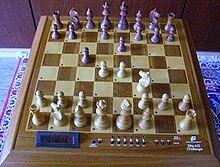Fidelity Electronics
| Fidelity International Inc.
|
|
|---|---|
| legal form | Corporation |
| founding | 1959 |
| resolution | 1989 |
| Reason for dissolution | Takeover by Hegener & Glaser |
| Seat |
Chicago , Illinois Miami , Florida (from January 1981) |
| management | President: Sidney Samole (from March 1970) Chairman of the Board: Myron Samole |
| Branch | microelectronics |
Fidelity Electronics Inc. (Fidelity International Inc.) was originally founded in Chicago in 1959 to trade hearing aids . It later produced cutting-edge technology in the field of biomedicine and, from 1976, with great success, micro- chess computers, which gave the pioneer a top position in the history of computer chess.
Medical equipment
In the early stages of its company history, Fidelity developed into a leading dealer of hearing aids and devices for diagnosing and researching diseases of the hearing organs . In March 1970, Sidney and Myron Samole took over the company as sole shareholders, which at the time had 35 employees. Within a few years, they expanded the premises, staff and product lines, including in the biomedical sector. The fidelity development of myo-electric hands, i.e. prostheses that can be controlled by the amputee's brain impulses , brought in the first state commission.
Chess computer
Sidney Samole is considered to be the spiritual father and the driving force behind the development of the first commercial computer chess game. He is said to have had the idea of using a computer to play the role of a human enemy while an episode of the Star Trek TV series was being broadcast . Samole got the engineer Ron Nelson , who designed the microcomputer called Fidelity Chess Challenger 1 in 1976 and also installed the first programs. Nelson later became the technical director of game computer production for Fidelity. The further software development was in the hands of the married couple Dan and Kathe Spracklen . After extensive work and improvement, Sid Samole decided to introduce the Fidelity Chess Challenger 7 model at Chicago's Consumer Electronics Show in January 1977. With 600,000 units sold, the product took the chess world by storm and marked the beginning of the development of ever new and more powerful chess computers in the 1980s .
After operations in Chicago were spread over 13 buildings and the number of employees had exceeded 250, the decision was made to expand significantly and, in 1978 , the construction of a new company headquarters with sufficient business space began in Miami , Florida. In 1980 there were over 1,250 employees. The games division brought building on the top brand Chess Challenger an entire Challenger product line with Checker Challenger (Engl. Dame ), Bridge -Challenger , Backgammon -Challenger and Othello -Challenger on the market. Through extensive advertising in the media and a clever patent policy, Fidelity achieved a leading position in the games market for the following years.
With early chess computers you had to enter your move on the keyboard. However, the Fidelity Elite A / S (picture left) was able to recognize the movement of the pieces themselves as early as 1983, as is the case with today's chess computers (e.g. through small magnets in the foot of the piece), which usually have the shape of a chessboard .
In addition to the Fidelity Hearing Instruments , other business units were important. Fidelity International Sales Corporation supplied the global export market through exclusive distributors in the most important countries with their own service centers and sales organizations. The European headquarters in Frankfurt am Main deserved special mention . The Fidelity Software Corporation in Nice started operations in 1980. This company employed many high-ranking European programmers and mainly supplied software for the world market to Fidelity Electronics in the USA. Another software development business was located in San Diego , California.
In 1989 the enterprising Sidney Samole recognized a recession in the market for dedicated microchess computers, which had become a major competitor in the cheaper and more powerful personal computers. In addition, the extremely deteriorating dollar exchange rate had a damaging effect on the important international Fidelity sales. So he sold Fidelity Electronics at top value to Hegener & Glaser , who, misunderstanding the real market situation, celebrated this as an “elephant wedding” and as a leap to the top of the world. A few years later they had to clear the field themselves. Sidney's son Shane, who founded Fidelity Canada in 1984, took a loan from his father and started Excalibur Electronics in 1992. Sidney Samole died on July 30, 2000.
Web links
- Chess computer: tricks and deceit . DER SPIEGEL 50/1980, accessed on August 19, 2013.
- Fidelity in the Schachcomputer.info community. History, chess computers, brochures, accessed September 10, 2013.
Individual evidence
- ↑ a b c d The Fidelity Story English; Retrieved September 12, 2013
- ↑ Ronald (Ron) Nelson: American electrical engineer and pioneer of microcomputer chess. Already in 1976 developed a chess program for an Altair 8800 microcomputer with an Intel 8080 CPU; was hired by Sid Samole as a programmer and engineer for Fidelity; wrote the first programs there, was also Fidelity's hardware engineer and, after the huge success of the Z80-based Fidelity Chess Challenger 7, went to Miami with the company. When Sid Samole hired Dan and Kathe Spracklen in 1980 to adapt their much stronger program Sargon III as Fidelity's flagship, Nelson focused on hardware, input / output and system programming. In 1989, after the takeover of Fidelity by Hegener & Glaser, Ron Nelson continued both technical development and chess programming as technical vice-president of Excalibur Electronics founded by Sidney Samole's son Shane Samole. Four Excalibur computers contain a Nelson program for an H8 processor.
- ^ A b Fidelity Electronics. Chess Programming Wiki, accessed September 10, 2013 (English, brief introduction, history, successes, products, sources).


